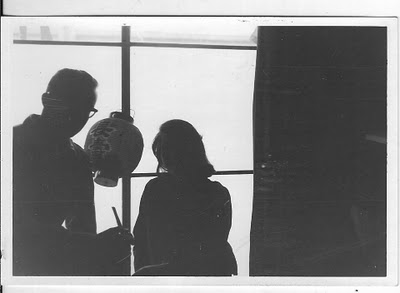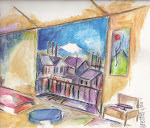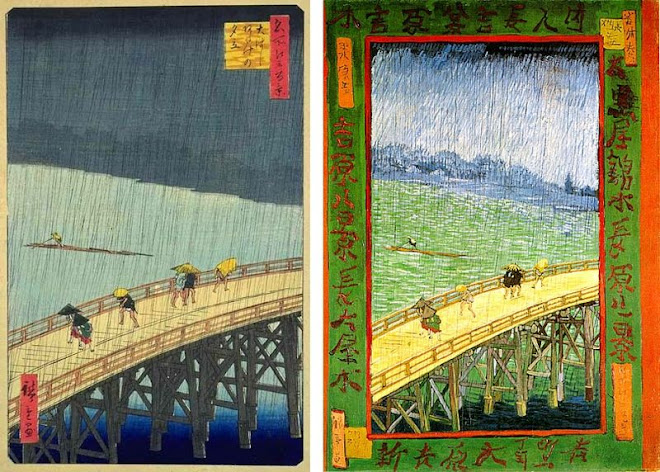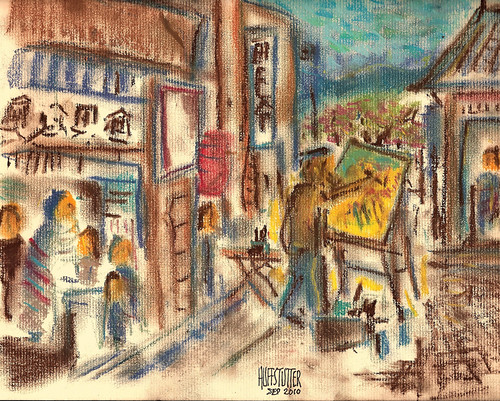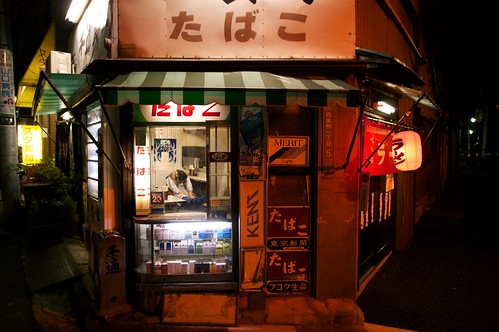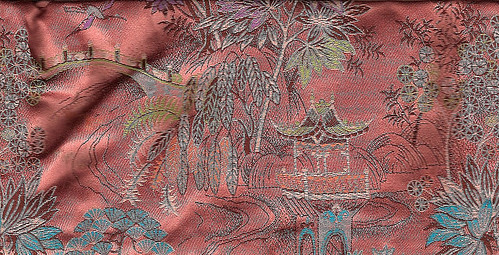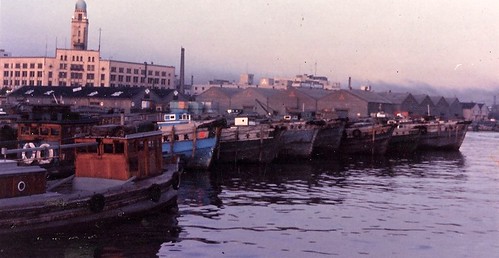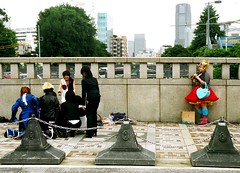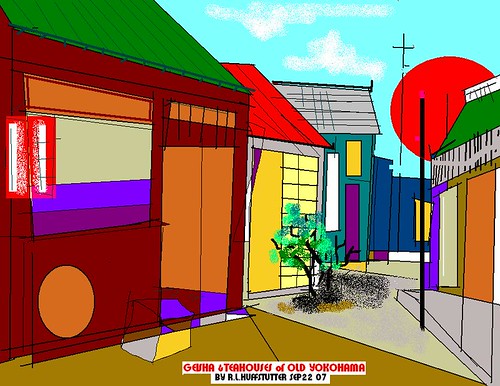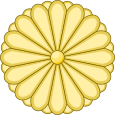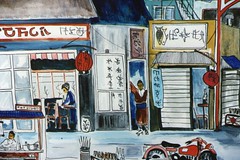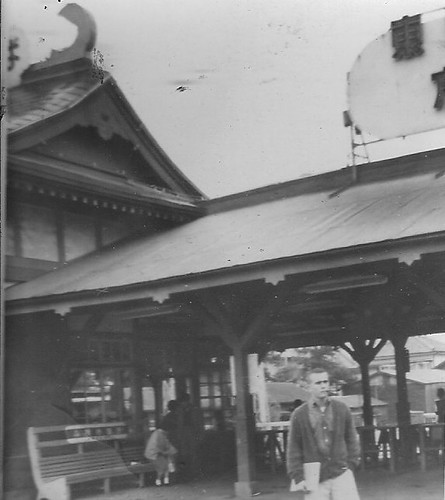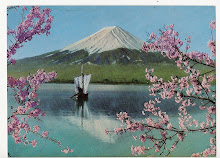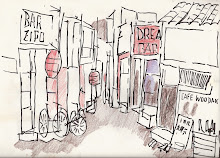YOKOHAMA PICTURE SHOW

Shot with my Petri in Yokohama 1962
RICE FIELD IN JAPAN 1962

I took this with my PETRI in Kanagawa Prefecture
Wednesday, March 30, 2011
Saturday, March 26, 2011
hibernate - IMGP1937
The moment I saw this photograph of a Japanese smoke shop on a corner, I smiled with delight, remembering so many scenes I recalled from my time in Japan during the early 1960s.
This is a photo that defines the Japan I remember from the 1960s. Your angle and perspective are perfect. This photo is perfect in every way, shape and form.
It is as though time has stood still, the lantern glowing on the right side, the mysterious venues on the left that is most likely the private residence of the shopkeeper. There are the signs advertising American cigarettes, a universal symbol for smokers.There is the shopkeeper at work stocking the shelves, not wasting time.
The canopy, the geometrics, and the lighting--all combine to make this a masterpiece.
____________________________________________________
hibernate - IMGP1937
Uploaded by chez_sugi on 8 Jan 11, 7.59AM PDT.
Wednesday, March 23, 2011
SILK
http://www.youtube.com/watch?v=x_vwxM5tHRk&feature=related
THIS MUSIC DESCRIBES THIS SILK MEMORY...
Tuesday, March 22, 2011
BLOGABOUTJAPAN: a blog by R.L.Huffstutter
HERE IS HOPING ALL WILL BE WELL VERY SOON.
BLOGABOUTJAPAN: a blog by R.L.Huffstutter
Yokohama Harbor in 1961. Photo taken with what was a brand new Petri camera. Processed from a slide. In the far right background are the factories of the Mitsubishi plant in the area. Most of the harbor boats were similar to those above and were multi-purpose vessels. From what I understand, the large maritime building in the background still remains.
Uploaded
The outcast's outcast
_____________________________________________________
The outcast's outcast
Uploaded by Tim Slessor on 14 Jun 10, 10.37AM PDT.
Akihabara
THIS IS WHY JAPAN IS SO UNIQUE. BEHIND EVERY SIGN IS A MIND THAT IS CREATING NEW WAYS TO AMUSE AND PRODUCE FUN AND MONEY. THE JOY OF THE JAPANESE MIND MIGHT BE SEEN IN THIS REAL COLLAGE OF COMMERCE.
_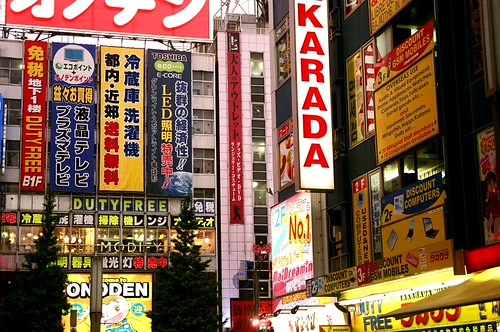 _____________________________________________________
_____________________________________________________
Akihabara
Uploaded by Tim Slessor on 17 Jun 10, 11.10AM PDT
Saturday, March 19, 2011
Ode to Tokyo
Ode to Tokyo
Originally uploaded by djspyhunter
________________________________________________________
Ode to Tokyo
I don't usually do video work, but having my D90 in Tokyo while experiencing all of the wonderful sights and sounds, I couldn't help but shoot some footage that hopefully captures some of the frantic & blissful feelings I had while there.
(Note: TV footage at the beginning was shot from my hotel TV)
Song is Teleportation, by Capsule.
Uploaded by djspyhunter on 27 Apr 09, 10.57AM PDT.
Friday, March 18, 2011
Thursday, March 17, 2011
FOX ANCHOR IN TOKYO CAN'T COMPREHEND JAPANESE


FOX'S $8 MILLION DOLLAR A YEAR ANCHOR, SHEPARD SMITH, DOESN'T COMPREHEND THE JAPANESE WAY OF LIFE. He says they have a really nice suite in Tokyo and that the staff is polite. He says they are made to feel very comfortable. But Shepard just doesn't seem happy. I am not surprised--I've met men like Shepard before. Shepard is wanting something to go down, something to happen, something that will focus the light on him.
So far, according to Shepard, they have seen no looting. What this super star of Fox doesn't understand is the difference between the lifestyles of the Japanese and the general populace of the deep South.
Shepard says he has heard rumors that there are Japanese who are thirsty, without water or food. (Perhaps he's looking for groups of people stranded on concrete viaducts like they were in Katrina.)
Remember how worked up everyone got after they had been stranded on the bridge for four days and couldn't get so much as a bottle of water? I remember it--I kept waiting for a helicopter to drop the folks some water and food, some baby formula. But this is not happening in Japan. Either the folks are getting water deliveries or they aren't screaming loud enough.
Shepard Smith is, it appears to me, very upset that he has yet to find a Japanese who is disgruntled. I am wondering if he is going up and down the Ginza interviewing.
Do you suppose he would find some grumbling if he got off the main drag and went down into the depths of Tokyo, down where there are no signs of any kind, just red glowing lanterns, places where men with a thirst for sake hang out? Shep' would be confused as the men bowed and tried to get him to down a few shots of real sake. And if the anchor man slammed a few shots of the sake, Old Shep' would soon understand the Japanese lifestyle, especially when he awoke the next morning, back in his comfy suite, wondering how in the hell he got back.
ANCIENT HISTORY OF JAPAN AND AREA CALLED JAPAN NOW

The Japanese Paleolithic age covers a lengthy period starting from around 100,000 to 30,000 B.C., when the earliest stone tool implements would have been found, and ending sometime around 12,000 B.C., at the end of the last ice age.
This timeline corresponds with the beginning of the Mesolithic Jōmon period. As the The Jōmon period has a start date of around 35,000 B.C, it is most generally accepted.[2]
The Japanese archipelago would become disconnected from the mainland continent after the last ice age, around 11,000 BC. After a hoax by an amateur researcher, Shinichi Fujimura, had been exposed,[3] the Lower and Middle Paleolithic evidence reported by Fujimura and his associates has been rejected after thorough reinvestigation.
As a result of the fallout over the hoax, now only some Upper Paleolithic evidence (not associated with Fujimura) can possibly be considered as having been well established.
[edit] Ancient Japan
[edit] Jōmon period
The Jōmon period lasted from about 14,000 BC until 500 BC. The first signs of civilization and stable living patterns appeared around 14,000 BC with the Jōmon culture, characterized by a Mesolithic to Neolithic semi-sedentary hunter-gatherer lifestyle of wood stilt house and pit dwellings and a rudimentary form of agriculture.
Weaving was still unknown at the time and clothes were often made of furs. The Jōmon people started to make clay vessels, decorated with patterns made by impressing the wet clay with braided or unbraided cord and sticks. Based on radio-carbon dating, some of the oldest surviving examples of pottery in the world can be found in Japan along with daggers, jade, combs made of shells, and varios other household items dated to the 11th millennium BC.[4]
Alternatively, the Metropolitan Museum of Art's Timeline of Art History [5] notes "Carbon-14 testing of the earliest known shards has yielded a production date of about 10,500 BC, but because this date falls outside the known chronology of pottery development elsewhere in the world, such an early date is not generally accepted.[6]
Calibrated radiocarbon measures of carbonized material from pottery artifacts: Fukui Cave 12500 +/− 350 BP and 12500 +/− 500 BP (Kamaki & Serizawa 1967), Kamikuroiwa rock shelter 12, 165 +/-350 years BP in Shikoku .[7] although the specific dating is disputed.
Clay figures known as dogū were also excavated. The household items suggest trade routes existed with places as far away as Okinawa.[citation needed] DNA analysis suggests that the Ainu, an indigenous people that live in Hokkaidō and the northern part of Honshū, are descended from the Jōmon and thus represent descendants of the first inhabitants of Japan.[citation needed]
[edit] Yayoi period

The Yayoi period lasted from about 400 or 300 BC to AD 250. This period followed the Jōmon period and completely supplanted it. This period is named after Yayoi town, the subsection of Bunkyō, Tokyo, where archaeological investigations uncovered its first recognized traces.
The start of the Yayoi period marked the influx of new practices such as weaving, rice farming, shamanism,[citation needed] and iron and bronze-making. Bronze and iron appear to have been introduced simultaneously into Yayoi Japan. Iron was mainly used for agricultural and other tools; whereas, ritual and ceremonial artifacts were mainly made of bronze. Some casting of bronze and iron began in Japan by about 100 BC, but the raw materials for both metals were introduced from the Asian continent.
Japan first appeared in written records in AD 57 with the following mention in China's Book of the Later Han:[8] "Across the ocean from Lelang are the people of Wa. Formed from more than one hundred tribes, they come and pay tribute frequently". The book also recorded that Suishō, the king of Wa, presented slaves to the Emperor An of Han in 107. The Sanguo Zhi, written in the 3rd century, noted the country was the unification of some 30 small tribes or states and ruled by a shaman queen named Himiko of Yamataikoku.
During the Han and Wei dynasties, Chinese travelers to Kyūshū recorded its inhabitants and claimed that they were the descendants of the Grand Count (Tàibó) of the Wu. The inhabitants also show traits of the pre-sinicized Wu people with tattooing, teeth-pulling, and baby-carrying. The Sanguo Zhi records the physical descriptions which are similar to ones on haniwa statues, such as men with braided hair, tattooing, and women wearing large, single-piece clothing.
The Yoshinogari site in Kyūshū is the most famous archaeological site of the Yayoi period and reveals a large settlement continuously inhabited for several hundred years. Archaeological excavation has shown the most ancient parts to be from around 400 BC. It appears the inhabitants had frequent communication with the mainland and trade relations. Today, some reconstructed buildings stand in the park on the archaeological site.[cSMALL SEA PORT IN JAPAN 1989, WATERCOLOR BY R.L. HUFFSTUTTER

SMALL SEA PORT IN JAPAN 1989, WATERCOLOR BY R.L. HUFFSTUTTER a photo by roberthuffstutter on Flickr.
SMALL SEA PORT IN JAPAN 1989, WATERCOLOR BY R.L. HUFFSTUTTER
Uploaded by roberthuffstutter on 17 Mar 11, 7.28AM PDT.
Wednesday, March 16, 2011
 When I recall my time spent in Japan in the early 60s, the Crown Prince and his beautiful bride Micheko were on the covers of almost every magazine and newspaper I came across. He was a handsome young man and his wife was beautiful and the first "commoner" to ever have been married in the Royal family.
When I recall my time spent in Japan in the early 60s, the Crown Prince and his beautiful bride Micheko were on the covers of almost every magazine and newspaper I came across. He was a handsome young man and his wife was beautiful and the first "commoner" to ever have been married in the Royal family.I found the public fascination with the young couple most unique. I can think of no better way to describe the romance. But the 60s were the romantic years of the last century. Ask anyone my age and they will agree. Having been born in the early 40s, I knew all about World War Two.
Afterall, I had seen John Wayne in "Sands of Iwo Jima" at least a dozen times by the time I arrived in Japan. I had also seen various versions of Madame Butterfly. Even before I arrived in Japan, the aria from the opera gave me goosebumps. Had Puccini written this opera for my girlfriend and me?
I ramble on, but when one is almost 70, they have earned the right to ramble.
VOICE OF THE CRANE: EMPEROR AKIHITO ADDRESSES THE NATION
 Akihito is the eldest son and the fifth child of Emperor Hirohito (the Showa Emperor) and Empress Kōjun. Titled Prince Tsugu (継宮, Tsugu-no-miya?) as a child, he was raised and educated by his private tutors and then attended the elementary and secondary departments of the Peers' School (Gakushuin) from 1940 to 1952.[2] Unlike his precedents in the Imperial Family, he did not receive a commission as an Army officer, at the request from his father, Hirohito.
Akihito is the eldest son and the fifth child of Emperor Hirohito (the Showa Emperor) and Empress Kōjun. Titled Prince Tsugu (継宮, Tsugu-no-miya?) as a child, he was raised and educated by his private tutors and then attended the elementary and secondary departments of the Peers' School (Gakushuin) from 1940 to 1952.[2] Unlike his precedents in the Imperial Family, he did not receive a commission as an Army officer, at the request from his father, Hirohito. During the American firebombing raids on Tokyo in March 1945, he and his younger brother, HIH Prince Masahito, were evacuated from the city. During the American occupation of Japan following World War II, Prince Akihito was tutored in English and Western manners by Elizabeth Gray Vining. He briefly studied at the Department of Political Science at Gakushuin University in Tokyo, though he never received a degree. Although he was Heir-Apparent to the Chrysanthemum Throne from the moment of his birth, his formal Investiture as Crown Prince (立太子礼, Rittaishi-no-rei?) was held at the Tokyo Imperial Palace on 10 November 1952. In June 1953, Crown Prince Akihito represented Japan at the coronation of Queen Elizabeth II in London.[2]
Then-Crown Prince Akihito and Crown Princess Michiko made official visits to thirty-seven countries. As an Imperial prince, Akihito compared the role of Japanese royalty to that of a robot; and he expressed the hope that he would like to help in bringing the Imperial family closer to the people of Japan.[3]
After the death of Emperor Hirohito on 7 January 1989, the crown prince received the succession (senso).[4] Emperor Akihito formally acceded to the throne (sokui)[4] on 12 November 1990.[2] In 1998, during a state visit to the United Kingdom, he was invested with The Most Noble Order of the Garter.
On 23 December 2001, during his annual birthday meeting with reporters, the Emperor, in response to a reporter's question about tensions with Korea, remarked that he felt a kinship with Koreans and went on to explain that in the Shoku Nihongi the mother of Emperor Kammu (736–806) is related to Muryeong of Korea, King of Baekje.[5]
Emperor Akihito underwent surgery for prostate cancer in January 2003.[6] Since succeeding to the throne, Emperor Akihito has made an effort to bring the Imperial Family closer to the Japanese people. The Emperor and Empress of Japan have made official visits to eighteen countries, as well as all forty-seven Prefectures of Japan.[2]
In response to the 2011 earthquake, tsunami and nuclear crisis, the Emperor made a rare televised appearance [7] urging his people not to give up hope and to help each other.
[edit] Marriage and children
| |
|
On 10 April 1959, he married Miss Michiko Shōda (born 24 October 1934), the eldest daughter of Mr. Hidesaburo Shōda, the president and later honorary chairman of Nisshin Flour Milling Company.[2][8] The new Crown Princess was the first commoner to marry into the imperial family. The Emperor and the Empress have three children:
- HIH The Crown Prince Naruhito (b. 23 February 1960, titled Hiro-no-miya or Prince Hiro),
- HIH The Prince Akishino (Fumihito, b. 30 November 1965, titled Aya-no-miya or Prince Aya) and
- Sayako Kuroda, formerly HIH The Princess Sayako (titled Nori-no-miya or Princess Nori, b. 18 April 1969).[2]
[edit] Official functions
| | This section does not cite any references or sources. Please help improve this article by adding citations to reliable sources. Unsourced material may be challenged and removed. (March 2011) |
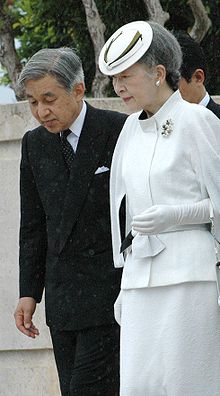
Despite being strictly constrained by his constitutional position, he also issued several wide-ranging statements of remorse to Asian countries, for their suffering under Japanese occupation, beginning with an expression of remorse to China made in April 1989, three months after the death of his father, Emperor Hirohito.
In June 2005, the Emperor visited the US territory of Saipan, the site of a battle in World War II from 15 June to 9 July 1944 (Battle of Saipan). Accompanied by Empress Michiko, he offered prayers and flowers at several memorials, honoring not only the Japanese who died, but also American soldiers, Korean laborers, and local islanders. It was the first trip by a Japanese monarch to a World War II battlefield abroad. The Saipan journey was received with high praise by the Japanese people, as were the Emperor's visits to war memorials in Tokyo, Hiroshima, Nagasaki, and Okinawa in 1995.
On 6 September 2006, the Emperor celebrated the birth of his first grandson, Prince Hisahito, the third child of the Emperor's younger son. Prince Hisahito is the first male heir born to the Japanese imperial family in 41 years (since his father Prince Akishino) and could avert a possible succession crisis as the Emperor's elder son, the Crown Prince, has only one daughter, Princess Aiko. Under Japan's current male-only succession law, Princess Aiko is not eligible for the throne. The birth of Prince Hisahito could mean that proposed changes to the law to allow Aiko to ascend the Chrysanthemum Throne will not go through after being temporarily shelved following the announcement of Princess Kiko's third pregnancy in February 2006.
[edit] Ichthyological research
In extension of his father's interest in marine biology, the Emperor is a published ichthyological researcher, and has specialized studies within the taxonomy of the family Gobiidae.[9] He has written papers for scholarly journals, namely Gene and the Japanese Journal of Ichthyology.[10]
He has also written papers about the history of science during the Edo and Meiji eras, which were published in Science[11] and Nature.[12] In 2005, a newly described goby was named Exyrias akihito in his honour.
Tuesday, March 15, 2011
A QUIET DAY IN JAPAN ENDED IN TRAGEDY
By Robert L. Huffstutter
"If we don't have some fun while we are able to laugh, smile and grin, with others and even while alone, what is the purpose of our presence on Earth?
I just received this month's National Geographic with some delightful photos taken of the Milky Way by the Hubble telescope. I looked at them with awe and admiration. How great it would be to go soaring in an out of "old body" experience. To spend eternity exploring this vast universe, soaring, soaring, marveling at the sights, many never yet seen by any telescope.
I thought about this and suddenly I felt depressed again.
To go soaring in all of this beauty--alone? No, that would be cruel. Oh, for a few years, waiting to be reunited with a friend or lover or spouse, that would be a breeze. But to soar about in the vast universe alone forever would be, for me, very lonely. After a few years of this lonely flight, I would certainly be screaming for another spirit with whom I could share the beauty.
There is so much we do not know about life while we are living, it tires my mind to try and figure out the scheme of things.
Why, for example, are there great tragedies like the ones we have seen during our lifetimes? I am referring to natural disasters, events some consider "acts of God." Well, they have that right. Do I get mad at God? Let each person ask themselves this question.
Think of the tragedies our children, some as young as five, have seen in their short lives. When we think of the sorrows those in their 80s and 90s have experienced, it is amazing that they are still, in many cases, able to rise in the mornings and enjoy their tea and coffee.
Of course, many of these tragedies like World War I, World War II, the Korean War, Vietnam, the mass murders in Africa, all began by deranged leaders, the religious wars throughout the world, the domestic acts of terrorism, these are neither "natural disasters" or "acts of God."
Human cruelty-- it goes on and on; it is still going on, cruelty and depravity created by man--these are not the "acts of God" though there are those who will disagree.
What happened in Japan is a natural disaster, tragedy created and caused by the forces of nature--energy out of control caused by an earthquake on the ocean floor. Yes, I speak of natural disasters.
While I admire those who are spending their lives trying to "cure" global warming, I believe that this type of geographical error created by civilization is the least of our concerns. When all of the efforts and energy expended by the sincere men and women to keep the earth environmentally correct, we can see what nature can do to totally ____up an orderly and sane society, a disaster that was created by no man or woman but by the forces of nature.
It is easy to get mad at nature. I am totally disappointed with Nature. It is Nature that rules the earth, the universe-- not mankind, not womankind. When will we realize this?
Nevertheless, there are those, now, who will re- focus on the hazards of nuclear energy. It will become yet another new way to funnel money from government to the men and women who naturally find causes to create large and personal bank accounts.
There will be those who will try and charge Japan for whatever damages might occur from their nuclear energy plants. Mark my word, at this very moment, there are government officials in numerous nations trying to figure out how to make Japan pay for what is a natural disaster
By Robert L. Huffstutter
SKETCH OF A YOUNG LADY, TOTSUKA 1963
Saturday, March 12, 2011
Tuesday, March 8, 2011
Stairways of Enoshima: My Final Poem About Enoshima by R.L.Huffstutter
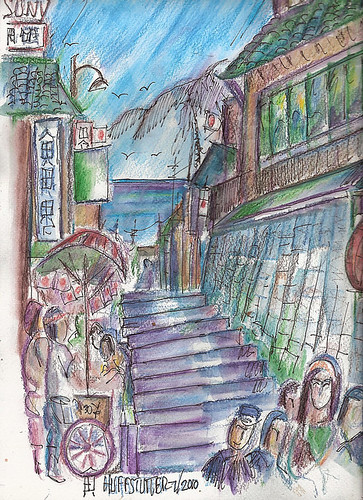
Stairways of Enoshima: My Final Poem About Enoshima by R.L.Huffstutter a photo by roberthuffstutter on Flickr.

____________________________________________________
Stairways of Enoshima: My Final Poem About Enoshima by R.L.Huffstutter
Upon waking on many mornings,
I am, for a moment, young again
and walking these ancient
stone steps of Enoshima,
alive with thoughts of a future
filled with the joys of
afternoon rains and time
for gentle romance.
We walk, hand in hand, her
smile so subtle, so sensual,
so full of the hope we had
for walking the steps of
stones of many nations
in our love affair that
began by chance, but
reality ends the dream
and I could cry, but no more tears
remain, just gentle rain and doubts
about how quickly dreams
disappear through the years.
Uploaded by roberthuffstutter on 7 Mar 11, 1.48AM PST.

